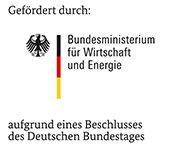16898 N

| Laufzeit: | 01.12.2013 - 31.05.2016 |
|---|---|
| Geldgeber: | Bundesministerium für Wirtschaft und Energie (BMWi) über AiF |
| Bearbeiter: | Sonja Madloch |
| Arbeitsgruppe: | Hochtemperaturwerkstoffe |
Metal dusting is a severe form of corrosion, which occurs in high carbon activity atmospheres at temperatures of 400-900°C (e.g. in reformer or coal gasification plants). Affected materials are steels and nickel base alloys because of the catalytic effect of nickel and iron on the dissociation of carbon-containing gas species, their carbon uptake, and subsequent graphite nucleation inside the material. Conventional protection is provided by dense oxide scale forming coatings and the use of alloys with high amounts of oxide scale forming elements.
Since metal dusting involves catalytic surface interactions, a new functional coating approach was developed at DECHEMA-Forschungsinstitut (DFI). Combination of an electrochemical nickel plating step with subsequent tin powder pack cementation led to the formation of an intermetallic Ni-Sn layer. Alloying nickel with tin blocks the catalytically active centers for surface reactions with carbon. It has been reported that graphite nucleation on nickel or cementite could be correlated with epitaxial similarities between those species [1], [2]. The change of the crystal structure of nickel by tin seems to inhibit the nucleation of graphite as well. Exposure tests of Ni-Sn coated samples (coating thickness 7-10 µm) at 650°C under metal dusting conditions (74% H2; 24% CO; 2% H2O) showed great improvement. Since the Ni-Sn coating is prone to oxidizing environments, the functional coating was further supplemented by an enrichment of oxide scale forming elements to provide a sufficient oxygen protection. The resulting coating provides dual protection by combining a classical oxide barrier (conventional approach) with catalytic inhibition.
[1] Z. Zeng, K. Natesan, V. A. Maroni, Oxid. Met. 58, 147-170 (2002)
[2] J. Zhang, C. Kong, D. J. Young, Mater. High Temp. 26, 45-55 (2009)
zurück
Das IGF-Vorhaben Nr. 16898 N der Forschungsvereinigung DECHEMA e.V., Theodor-Heuss-Allee 25, 60486 Frankfurt am Main wurde über die AiF im Rahmen des Programms zur Förderung der industriellen Gemeinschaftsforschung (IGF) vom Bundesministerium für Wirtschaft und Energie aufgrund eines Beschlusses des Deutschen Bundestages gefördert.
PD Dr. Mathias Galetz
Tel.: 069 / 7564-397
E-Mail: mathias.galetz
S. Madloch, A.S. Dorcheh, M.C. Galetz, Oxidation of Metals 89 (2018), 483
S. Madloch, M.C. Galetz, Surface and Coatings Technology 315 (2017), 335
S. Madloch, M.C. Galetz, C. Geers, M. Schütze, Surface and Coatings Technology 299 (2016), 29